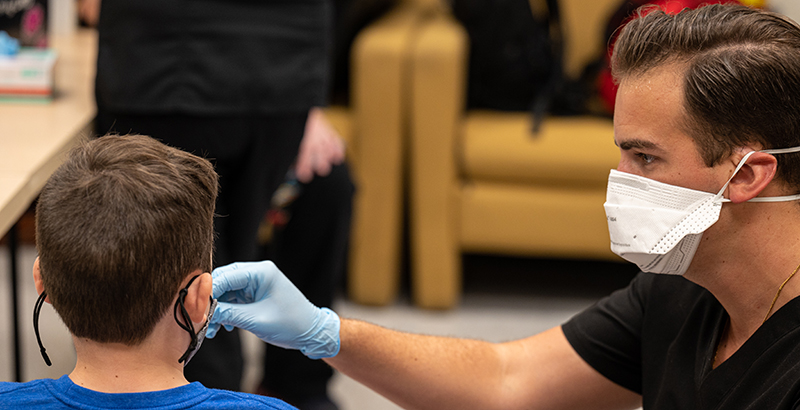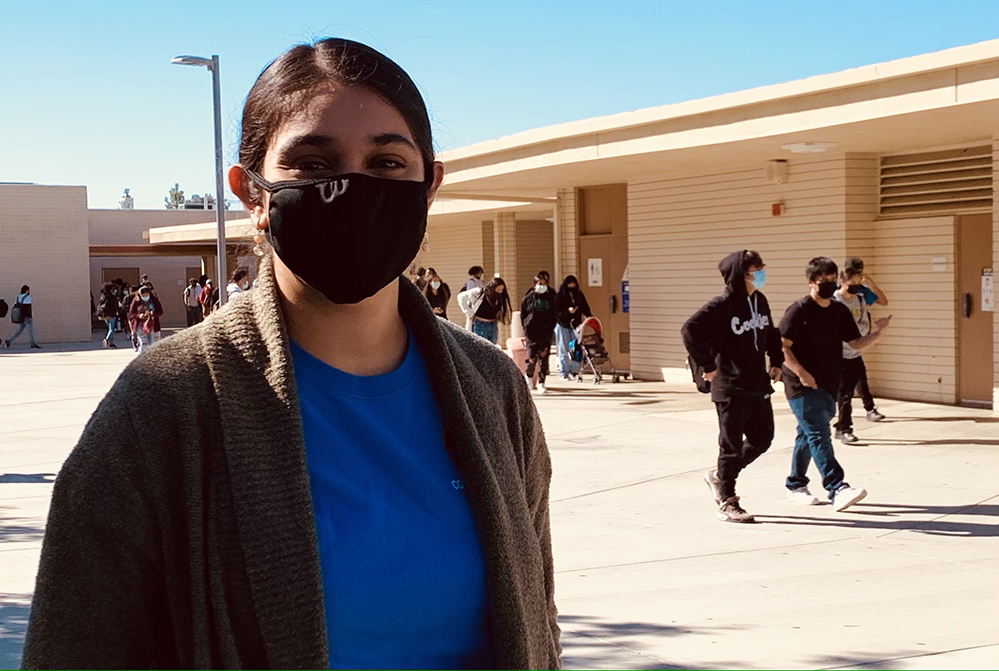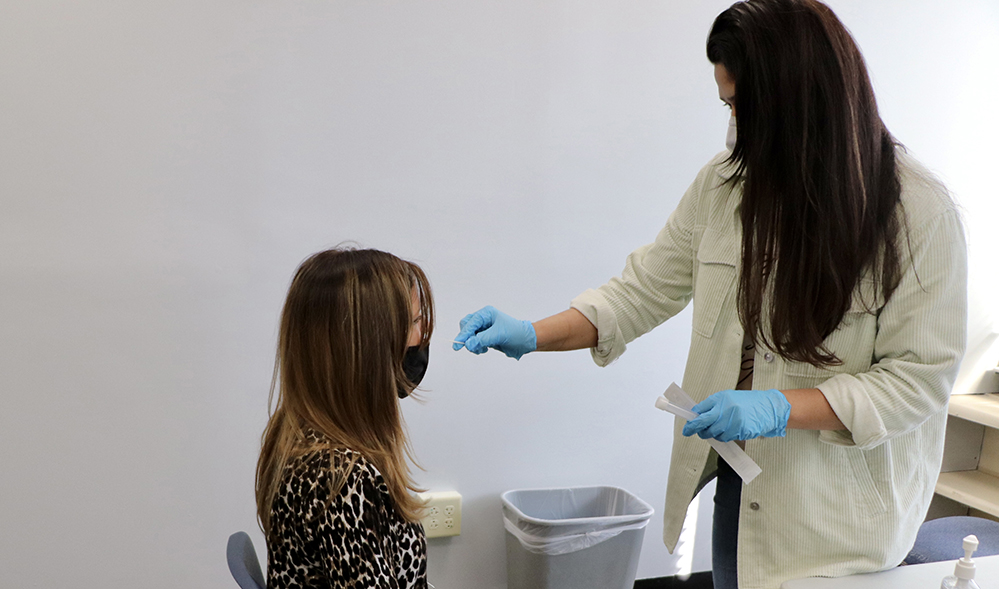‘Caught Flat-Footed’: As Biden, CDC Urge Widespread COVID Testing in Schools, Districts Around the Country Struggle to Make It Happen

Get stories like this delivered straight to your inbox. Sign up for The 74 Newsletter
In the “isolation room” at Indian Springs High School — the command center for any COVID-related issues on campus — Janak Kaur seals the school security officer’s swab sample in a plastic bag. Meanwhile, the officer fills out a registration on a website where he’ll get his results in a day or two.
As the school’s COVID liaison — one of 76 based at each of the San Bernardino City district’s schools — Kaur sometimes handles 20 tests a day, but she’s expecting to get a lot busier. California’s mandate that all school employees be vaccinated or get tested weekly went into effect Oct. 15. San Bernardino County includes the least-vaccinated zip code in Southern California, and its overall 49 percent rate is lower than that of many counties in the state. Kaur said some residents think “COVID isn’t real.”

Fearing that testing and contact tracing would take staff members’ time away from instruction, the district is spending $12.6 million in federal funds on a contract with a public health staffing agency, AM LLC, to place a liaison in each school.
“We’re trying to stay in the business of education and not dabble in the business of public health,” said Eric Verete, the district’s safety and emergency manager. He frequently hears from administrators in other districts who are struggling to manage the process on their own. “We were well ahead of the game,” he said.
But many districts across the country are behind. As the Biden administration urges states to increase testing in schools — and take advantage of $10 billion in federal funding earmarked for that purpose — and the Centers for Disease Control and Prevention promotes test-to-stay programs as a way for students exposed to COVID-19 to avoid quarantine, schools are under pressure to ramp up testing. Some have reassigned staff members and hired more specifically to manage the testing process, while others are pushing back against the additional burden. And though a vaccine for elementary school students is expected soon, some experts say the need for testing won’t disappear.
“Some sort of testing will be part of our lexicon going forward,” said Mara Aspinall, a professor at Arizona State University. Especially in districts without mask mandates, she added, weekly surveillance testing — swabbing a random sample of a school’s population — could be an effective way to minimize outbreaks.
‘Caught flat-footed’
Districts that started testing programs last school year, such as Baltimore, Los Angeles and San Antonio, were able to resume or expand them this fall.
Shari Camhi, superintendent of the 4,500-student Baldwin Union Free School District, near New York City, decided to implement testing because of her own frustration in December, when there was an uptick in positive cases.
She found herself “going to five different places … and couldn’t get tested anywhere,” she said. “We just needed to make it easier for people.”

Mastery Schools, a network of charters in Philadelphia and Camden, New Jersey, began offering surveillance testing in February, through a federal program that preceded the $10 billion allocation. That’s what local private schools were doing, said Laura Clancy, Mastery’s senior adviser of health and safety. Adding that it’s hard to find free testing in the community, she called the program “an additional layer of assurance for staff and parents.”
But districts that didn’t test last school year — and maybe thought the virus was going to be mostly under control this fall — were “caught flat-footed, with no time to prepare” when school reopened, said Leah Perkinson, pandemics manager at the Rockefeller Foundation. She described testing in school for the first time as “taking your entire school on a field trip to a place that no one has ever been to before.”
The foundation launched a program this year to match schools with testing vendors. But Aspinall, who advises Rockefeller, said obstacles remained in many communities despite the availability of federal funds. And now, increased demand is straining both districts and vendors.
Some resistant officials had a change of heart after it became clear the Delta variant would continue to interfere with in-person learning. Idaho lawmakers turned down the state’s portion of the $10 billion in the spring, but Gov. Brad Little later made other relief funds available to school districts. In New Hampshire, the Conway School District initially opted out of the state’s Safer at School Screening program, but this month changed course after several student athletes tested positive.
In Massachusetts, Gov. Charlie Baker has asked for the National Guard’s help because the state’s testing vendor is short-staffed and schools were using their own employees to test and contact-trace.
“Nurses were becoming overwhelmed because of the demands on their time,” said Thomas Scott, executive director of the Massachusetts Association of School Superintendents. The state considered bringing in more vendors, he added, but said other companies were having the same challenges.
In New Mexico, Joshua Landry, a nurse at Chaparral Middle School in Alamogordo, said COVID testing and tracing now “consumes the majority of my day.” He has less time to work on individualized education plans for students with disabilities or to follow up with children who have asthma, diabetes or other health conditions that require medication and monitoring.
He’s had to call an ambulance three times this school year for emergencies, such as a student with asthma who didn’t have an inhaler at school.
In other states and districts, leaders have decided they can’t spare staff members for testing-related responsibilities when they’re still adjusting to having all students back at school. In Pennsylvania, less than 400 of the state’s 5,000 public and private schools have reportedly opted into the testing program. And in Colorado’s Poudre School District, Superintendent Brian Kingsley said this month that participating in the state’s program would divert staff members’ time away from their “core business” of educating students.
While the state health department “provides a lot of resources to stand up these programs in public schools across the state of Colorado, it’s not enough to do it without having a significant impact on schools, on staffing,” he said at a board meeting. “Students don’t walk themselves to a testing center.”
In the Mastery network, Clancy said parents with younger students are more comfortable participating if they already know the school nurses and health aides conducting the testing. Older students swab their own nostrils in class, overseen by their teachers, because it wasn’t feasible to test students at lunch or as they entered school in the morning.
But getting permission is a challenge for schools serving populations where “huge chunks of our parents don’t have an email address,” Clancy said, adding that lack of internet access is especially problematic when a child has symptoms. “If you can’t get that person on the phone, you’re not going to be able to get consent.”
Lingering misconceptions about the role of testing are another ongoing challenge, she said. Some parents think that if they consent to their child being tested, they’re also agreeing to a vaccine. Older students have said they feel they can put off vaccination until college because they’re participating in their school’s testing program.
‘Highly complex environment’
Balancing the interests of parents, school board members, children and school staff has been a challenge for vendors as well, Aspinall said, calling a school a “highly complex environment.”
“Working with schools is not the same as working with businesses or retail pharmacies,” she said. “You have to have a lot of patience because you’re dealing with an institution that was not built to be a health care provider.”
David Savitsky, CEO of ATC Healthcare Services, which provides testing in the Baldwin district and hundreds across the country, said his teams try to set up outside, weather permitting, to minimize the impact on schools. Currently, his sites are testing more unvaccinated employees than students, but he expects that to change with the Thanksgiving and winter holidays approaching, because students could be exposed to more people.
He added that the availability of vaccines for younger students, expected within days, could prompt more districts to add surveillance testing for families who choose not to get their children inoculated.
“We’re not going to be part of that discussion, but hopefully we’re part of the solution,” he said.
In San Bernardino, Verete said he wasn’t even sure what he needed when he first reached out to AM LLC. He just knew contract tracing was going to eat up a lot of time. At the high school, it can take Kaur at least an hour to confer with a student’s teachers, advisers and — if the student is an athlete — coaches. Then she has to reach the students’ families.
Kaur, who works for AM LLC, earned her undergraduate degree in public health and, as a former intern at the Los Angeles County Department of Health, learned to stand up to vaccine opponents.
“I’ve had my fair share of people fighting back,” she said.
Opposed to vaccines or not, parents were concerned about sending their children back to school this fall, and she was bombarded with questions about active cases on campus until the district launched its COVID-19 dashboard.
She handles required testing for student athletes and unvaccinated employees, but also sees walk-ins wondering whether their sore throat or headache is COVID-related.
The district’s original contract with AM LLC was for six months. But Verete extended it for the rest of the school year.
“It’s beneficial to have someone there, knowing their job is to deal with COVID,” he said. “It’s not going away like we wanted it to.”
Get stories like these delivered straight to your inbox. Sign up for The 74 Newsletter

;)
